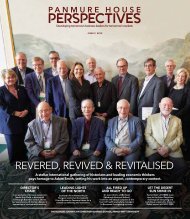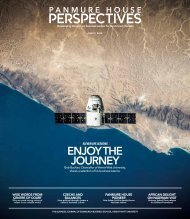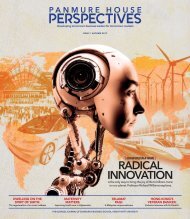Panmure House Perspectives - Issue 4, 2019
Panmure House Perspectives, the new international business journal of Edinburgh Business School, which showcases the best research undertaken by our doctoral students, interviews with major global business figures and viewpoints from leading academics from or own university and beyond.
Panmure House Perspectives, the new international business journal of Edinburgh Business School, which showcases the best research undertaken by our doctoral students, interviews with major global business figures and viewpoints from leading academics from or own university and beyond.
You also want an ePaper? Increase the reach of your titles
YUMPU automatically turns print PDFs into web optimized ePapers that Google loves.
Tommy Hilfiger’s stated<br />
goals for 2020, it include<br />
piloting services of ‘click<br />
and collect’, which enables<br />
consumers to order from<br />
the Tommy.com online shop<br />
and collect items from one of its<br />
bricks-and-mortar stores; and<br />
‘stock visibility online’, which<br />
enables consumers to check<br />
online if certain items<br />
are available offline.”<br />
THE OMNICHANNEL STUDY<br />
The research involved both formal and informal interviews with<br />
key team members and departments within Tommy Hilfiger who<br />
were working on the omnichannel strategy. A series of questions<br />
was also formulated asking about the considerations involved<br />
in deciding to go omnichannel. It was clear from respondents<br />
that this is interpreted differently by different stakeholders,<br />
even within the same organisation. However, all agreed that the<br />
business had to be consumer centric and focused on delivering<br />
change.<br />
Dr Wintjes concluded that secondary initiatives such as click<br />
and collect can only be decided on if companies have a clear<br />
definition of their strategy. Yet, fashion industry companies need<br />
to respond rapidly to customer demands and are therefore often<br />
pushed towards short-term implementation to get something<br />
online as soon as possible. Fashion retail brands have little<br />
choice but to press on with this solution, often without<br />
conducting a readiness check.<br />
As one respondent said: ”If fashion retail brands do not offer<br />
advanced omnichannel services and innovations, they miss [the<br />
chance] to stay relevant and run the danger that they disappear”.<br />
Pointing out that all companies should analyse their<br />
processes and systems, Dr Wintjes asked what kind of analysis<br />
Tommy Hilfiger undertook before deciding to go omnichannel.<br />
Again, it was shown that in such a fast-moving industry, it<br />
was not possible to do an exact return on investment (ROI)<br />
calculation. Several respondents said an ROI calculation was<br />
difficult because there were too many assumptions and a<br />
clear outcome was not easy to calculate. As one respondent<br />
emphasised: “staying relevant was more important than<br />
calculating ROI”.<br />
THE IMPERATIVES OF IT AND DATA<br />
Furthermore, it was argued that all IT systems and processes<br />
needed to be aligned to implement omnichannel initiatives.<br />
Using big data wisely can help develop better thinking. One<br />
respondent said good project management preparation is the<br />
key for omnichannel success. In order to set up and implement<br />
an omnichannel strategy across the company and between<br />
all departments, a strong team or person with a direct link<br />
to the CEO is needed. This team or person is responsible for<br />
overseeing all processes and coordinates and manages the<br />
entire transformation across the company.<br />
TRADITIONAL<br />
Customers shop at<br />
bricks-and-mortar stores.<br />
E-COMMERCE<br />
Customers shop online, using<br />
laptops and computers.<br />
MULTICHANNEL<br />
Customers shop via<br />
multiple channels, using<br />
mobile phones and tablets.<br />
OMNICHANNEL<br />
Customers engage<br />
anywhere via integrated,<br />
seamless experiences.<br />
Source: Author’s own illustration,<br />
October 2017.<br />
ABOUT TOMMY HILFIGER<br />
Tommy Hilfiger was founded by its eponymous designer in<br />
New York in 1985 and is one of the world’s leading designer<br />
brands. With its classic American cool style, Tommy Hilfiger’s<br />
products are well known for premium styling, quality and value.<br />
In the fashion market, Tommy Hilfiger is positioned in the<br />
‘accessible luxury segment’. This is the premium segment below<br />
‘haute couture’ and ‘pure luxury fashion brands’ such as Chanel,<br />
Burberry or Armani, but above ‘middle and mass market’ brands<br />
such as Esprit, Zara, or H&M. It competes with the likes of Polo,<br />
Ralph Lauren and Hugo Boss.<br />
The company sells fashion products and merchandise, still<br />
designed by Hilfiger, including Tommy Jeans, Tommy Sport<br />
and several lines of products in menswear, womenswear,<br />
childrenswear, accessories, underwear and footwear. In addition,<br />
numerous product groups, including fragrances, eyewear,<br />
watches and home furnishing, are managed under licensing<br />
agreements.<br />
The company sells to third-party retailers and distributors,<br />
either in stores or online. The European consumer range<br />
consists of large department stores such as Peek &<br />
Cloppenburg in Germany, El Corte Inglés in Spain and<br />
Printemps in France, international online pure players,<br />
including Zalando, Asos and Amazon, as well as smaller<br />
independent retailers.<br />
Tommy Hilfiger, which was acquired by PVH Corp. in 2010,<br />
employs around 15,000 associates globally, while managing<br />
1,800 freestanding stores around the globe in over 100<br />
countries. The brand’s anchor stores can be found on some of<br />
the most famous high streets such as Fifth Avenue in New York,<br />
Regent Street in London, and Omotesando in Tokyo. Global<br />
retail sales reached approximately $7.4 billion in 2017.<br />
Tommy Hilfiger has defined its goal as becoming an<br />
omnichannel retailing fashion brand engaging consumers<br />
everywhere via integrated, seamless experiences. Tommy<br />
Hilfiger follows its defined rolling vision to be the world’s<br />
favourite American designer brand, with its mission to excite<br />
and inspire consumers. Tommy Hilfiger focuses on being<br />
consumer centric, adapting to change and to making products<br />
the priority. The company has the ambition to become a<br />
$10-billion global retail sales brand in 2020.<br />
All interviewees stressed the necessity of building an<br />
omnichannel transformation team, consisting of project<br />
managers and distribution channel specialists, as well as IT<br />
solution architects. It is recommended that this core team is<br />
directly linked to the CEO, as change management has to be<br />
driven from the top. Key questions were: is the company able<br />
to operate an integrated system across different distribution<br />
channels and consumer touch points? Is there an omnichannel<br />
transformation team in place that consists of the right people<br />
with a direct link to the company’s CEO?<br />
THE INVOLVEMENT OF THE WHOLE BUSINESS<br />
What became clear is that the whole organisation needs to<br />
be on the omnichannel journey once a fashion retail brand<br />
decides to implement its strategy. The biggest challenges are<br />
culture and mindset, and adopting an omnichannel philosophy<br />
in all parts of a business.<br />
The study found that companies which have full control<br />
over their distribution channels find it easier to implement an<br />
omnichannel strategy. Once the strategy is clearly defined, an<br />
action plan is required. At Tommy Hilfiger a discussion took<br />
place about what such a plan should look like. One view was<br />
that there was no magic formula which companies can copy<br />
and paste in order to make an omnichannel strategy work for<br />
them.<br />
“Companies need to start, try, test and learn, adjust and<br />
repeat.”<br />
Or as someone else put it: “There is no cookbook.<br />
Consumers change all the time. You need to trial and error.’’<br />
Companies need to find and create an environment that<br />
allows them to try different initiatives and to analyse what<br />
works. They should not be reluctant to start without having<br />
a full strategic plan in place. Rather, they need to be able to<br />
jump in.<br />
“This causes some stress, workarounds, and is certainly no<br />
ideal situation or set-up, but it is part of dealing with the fastchanging<br />
environment.’’<br />
However, there was also a need to make assumptions and<br />
analyse the potential of each tested omnichannel initiative. It<br />
was important not to run blindly but to measure from day one.<br />
Dr Wintjes used his findings to identify 10 key stages in<br />
creating an omnichannel strategy: (right)<br />
Once a fashion retail brand<br />
decides to implement its<br />
strategy, this has to be done<br />
within the entire organisation.<br />
The biggest challenge is culture and<br />
mind-set with companies and to adopt<br />
an omnichannel philosophy in all parts<br />
of a business.”<br />
THE RESEARCH OUTCOMES<br />
This thesis was successful in developing a standardised<br />
omnichannel process model which can be used in different<br />
channel combinations.<br />
Dr Wintjes also developed a road map for Tommy Hilfiger<br />
which includes recommendations concerning how to implement<br />
an effective omnichannel set-up. This successfully addressed<br />
the research question of how to build an effective management<br />
strategy for fashion retail brands, in particular, a holistic and<br />
effective omnichannel management strategy based upon the<br />
case study of Tommy Hilfiger.<br />
The Development of a Strategic Omnichannel Strategy for<br />
Fashion Retail Brands: the Case of Tommy Hilfiger, by DR JAN<br />
PHILIPP WINTJES. Submitted for the degree of Doctor of<br />
Business Administration at Edinburgh Business School, Heriot-<br />
Watt University, November 2018.<br />
10<br />
STEPS FOR DEVELOPING AN<br />
OMNICHANNEL STRATEGY<br />
1. CONSUMER FOCUS<br />
Findings confirm advancement of consumer<br />
shopping behaviour towards being experiential<br />
pushed by digitalisation. Findings recommend<br />
to revise any theory by incorporating changing<br />
consumer focus.<br />
2. OMNICHANNEL DEFINITION<br />
Findings discover need to expand any<br />
omnichannel strategy approach by a clear and<br />
common definition. As omnichannel is pushed by<br />
digitalisation, the definition should incorporate<br />
digital focus.<br />
3. ROLLING VISION STATEMENT<br />
Findings confirm need for formulating and calling<br />
out vision statement. Findings refine approach<br />
by outlining need for creating a rolling vision<br />
statement.<br />
4. ROLE OF THE CHANNEL<br />
STRATEGY<br />
Findings confirm need to define channel-specific<br />
strategies. Findings refine strategic theories by<br />
adding importance of holistic omnichannel view.<br />
5. IT INFRASTRUCTURE<br />
Findings confirm functional business process<br />
system as prerequisite for successful<br />
implementation. Findings add detail of efficient<br />
master data management to be key prerequisite.<br />
6. CHANGE MANAGEMENT<br />
Findings confirm top management involvement as<br />
essential. Findings expand approach by combining<br />
change management and common target setting.<br />
7. STRATEGY IMPLEMENTATION<br />
Findings confirm customer and format strategy as<br />
being prerequisite for implementation. Findings<br />
add third pillar of channel strategy as prerequisite.<br />
8. ORGANISATIONAL SET-UP<br />
Findings outline necessity to establish core<br />
team to follow successful and efficient strategy<br />
implementation within any organisation.<br />
9. WHOLESALE BUSINESS<br />
Findings recommend expansion of any theoretical<br />
model by incorporating the distribution channel of<br />
wholesale.<br />
10. OMNICHANNEL TEST FIELD<br />
Findings extend existing solutions on<br />
implementation by introducing way towards an<br />
omnichannel test field.<br />
Source: Tommy Hilfiger documents, September 2016.<br />
30 PANMURE HOUSE PERSPECTIVES ISSUE 4 ISSUE 4 PANMURE HOUSE PERSPECTIVES 31







